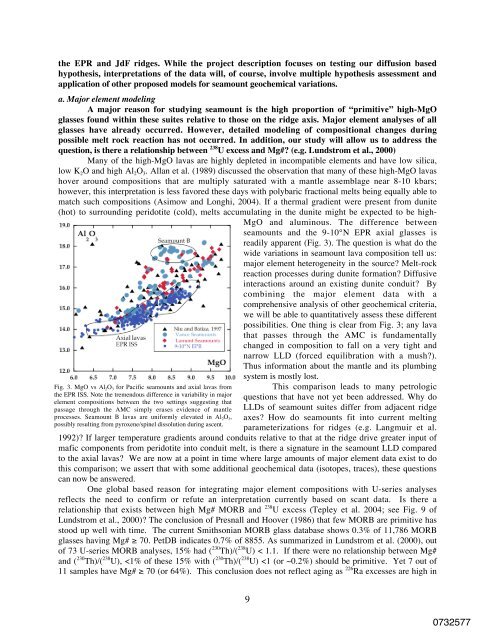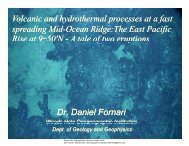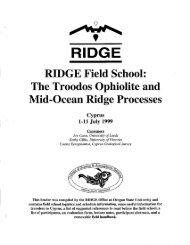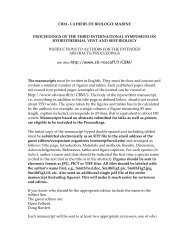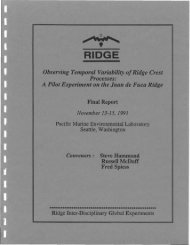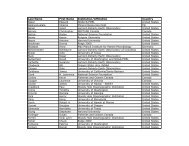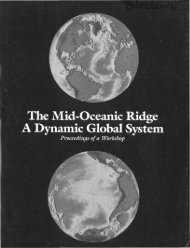You also want an ePaper? Increase the reach of your titles
YUMPU automatically turns print PDFs into web optimized ePapers that Google loves.
the EPR and JdF ridges. While the project description focuses on testing our diffusion based<br />
hypothesis, interpretations of the data will, of course, involve multiple hypothesis assessment and<br />
application of other proposed models for seamount geochemical variations.<br />
a. Major element modeling<br />
A major reason for studying seamount is the high proportion of “primitive” high-MgO<br />
glasses found within these suites relative to those on the ridge axis. Major element analyses of all<br />
glasses have already occurred. However, detailed modeling of compositional changes during<br />
possible melt rock reaction has not occurred. In addition, our study will allow us to address the<br />
question, is there a relationship between 238 U excess and Mg#? (e.g. Lundstrom et al., <strong>2000</strong>)<br />
Many of the high-MgO lavas are highly depleted in incompatible elements and have low silica,<br />
low K 2 O and high Al 2 O 3 . Allan et al. (1989) discussed the observation that many of these high-MgO lavas<br />
hover around compositions that are multiply saturated with a mantle assemblage near 8-10 kbars;<br />
however, this interpretation is less favored these days with polybaric fractional melts being equally able to<br />
match such compositions (Asimow and Longhi, 2004). If a thermal gradient were present from dunite<br />
(hot) to surrounding peridotite (cold), melts accumulating in the dunite might be expected to be high-<br />
MgO and aluminous. The difference between<br />
seamounts and the 9-10°N EPR axial glasses is<br />
readily apparent (Fig. 3). The question is what do the<br />
wide variations in seamount lava composition tell us:<br />
major element heterogeneity in the source? Melt-rock<br />
reaction processes during dunite formation? Diffusive<br />
interactions around an existing dunite conduit? By<br />
combining the major element data with a<br />
comprehensive analysis of other geochemical criteria,<br />
we will be able to quantitatively assess these different<br />
possibilities. One thing is clear from Fig. 3; any lava<br />
that passes through the AMC is fundamentally<br />
changed in composition to fall on a very tight and<br />
narrow LLD (forced equilibration with a mush?).<br />
Thus information about the mantle and its plumbing<br />
system is mostly lost.<br />
This comparison leads to many petrologic<br />
questions that have not yet been addressed. Why do<br />
LLDs of seamount suites differ from adjacent ridge<br />
axes? How do seamounts fit into current melting<br />
parameterizations for ridges (e.g. Langmuir et al.<br />
1992)? If larger temperature gradients around conduits relative to that at the ridge drive greater input of<br />
mafic components from peridotite into conduit melt, is there a signature in the seamount LLD compared<br />
to the axial lavas? We are now at a point in time where large amounts of major element data exist to do<br />
this comparison; we assert that with some additional geochemical data (isotopes, traces), these questions<br />
can now be answered.<br />
One global based reason for integrating major element compositions with U-series analyses<br />
reflects the need to confirm or refute an interpretation currently based on scant data. Is there a<br />
relationship that exists between high Mg# MORB and 238 U excess (Tepley et al. 2004; see Fig. 9 of<br />
Lundstrom et al., <strong>2000</strong>)? The conclusion of Presnall and Hoover (1986) that few MORB are primitive has<br />
stood up well with time. The current Smithsonian MORB glass database shows 0.3% of 11,786 MORB<br />
glasses having Mg# ! 70. PetDB indicates 0.7% of 8855. As summarized in Lundstrom et al. (<strong>2000</strong>), out<br />
of 73 U-series MORB analyses, 15% had ( 230 Th)/( 238 U) < 1.1. If there were no relationship between Mg#<br />
and ( 230 Th)/( 238 U),


